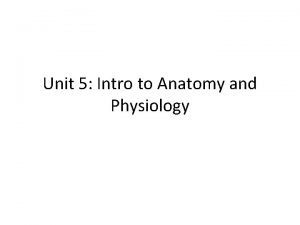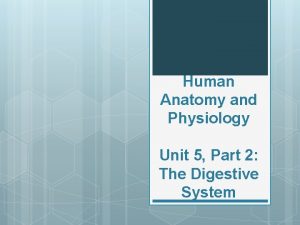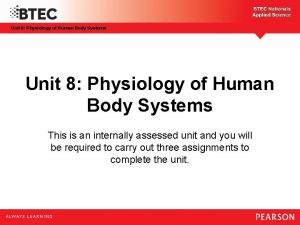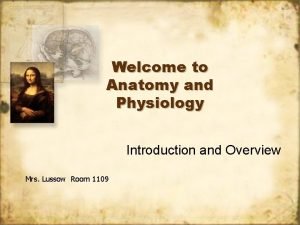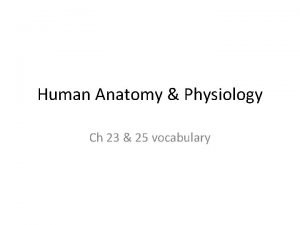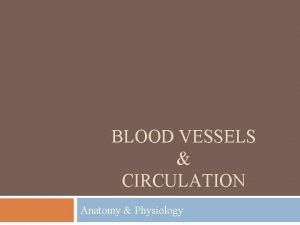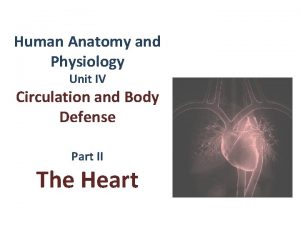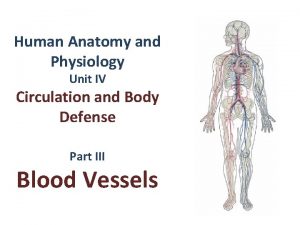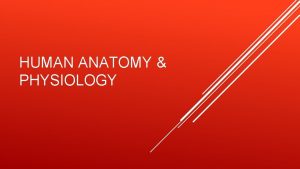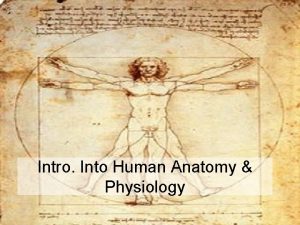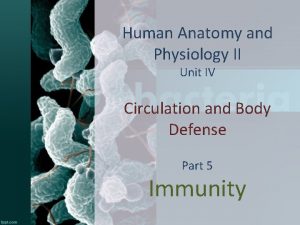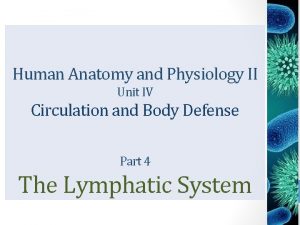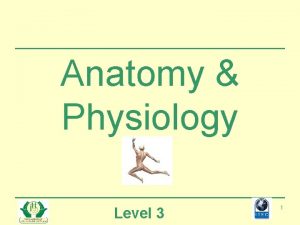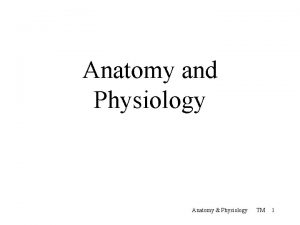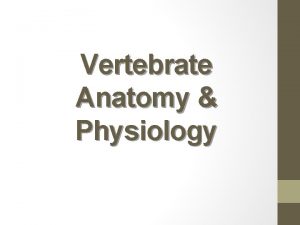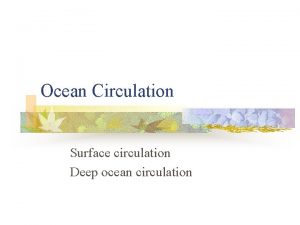Human Anatomy and Physiology II Unit IV Circulation



























































- Slides: 59

Human Anatomy and Physiology II Unit IV Circulation and Body Defense Part II The Heart

Unit Topics � � � Part 1 Blood Part 2 Heart Part 3 Blood Vessels Part 4 Lymphatic System Part 5 Immunity

The Cardiovascular System The cardiovascular system enables the rapid transport of nutrients, respiratory gases, waste products, and cells within the body.

Introduction � 100, 000 x beats per day �Right side vs. left side � 7, 000 -14, 000 L / day when inactive �What’s yours? �Cardiology study of the heart

Heart Topics 1. 2. 3. 4. 5. 6. 7. 8. Location of the Heart Chambers of the Heart Valves Coronary Circulation Cardiac Muscle Cardiac Conduction System Cardiac Cycle Cardiac Output

Location of the Heart � Size of fist � Located in the mediastinum. � Two-thirds lies to left of midline. � Upper third = great vessels

Location of the Heart Rests on the diaphragm � ◦ Phrenic nerve The heart is enclosed and held in place by the double layered pericardium. 1. Outer fibrous pericardium � 2. Inner serous pericardium A. Parietal layer B. Visceral layer

Location of the Heart � Surfaces of the heart

Pericardium

Pericardium

Pericardium Parietal pericardium Visceral Pericardium

Pericardial Diseases Pericarditis ◦ Inflammation of the pericardium � Pericardial effusion ◦ Build up of fluid in the pericardial cavity ◦ Often due to congestive heart failure � Cardiac tamponade ◦ Bleeding into the pericardial cavity �

Heart Topics 1. 2. 3. 4. 5. 6. 7. 8. Location of the Heart Chambers of the Heart Valves Coronary Circulation Cardiac Muscle Cardiac Conduction System Cardiac Cycle Cardiac Output

Location of the Heart � The wall of the four-chambered heart has three layers: 1. Epicardium 2. Myocardium 3. Endocardium

Layers of the Heart Wall

Inflammation of Heart Wall �Myocarditis ◦ Inflammation of myocardium ◦ Usually viral �Endocarditis ◦ Inflammation of endocardium ◦ Usually bacterial

Chambers of the Heart � Right atrium � Right ventricle � Left atrium � Left ventricle

Chambers of the Heart Right atrium and right ventricle pump blood to the lungs. � Left atrium and left ventricle pump blood to the rest of the body. � Auricles �

Coronary Sulci � Coronary sulcus � Anterior interventricular sulcus � Posterior interventricular sulcus

Right Atrium Forms the right border of the heart � Receives blood from: � ◦ Superior vena cava ◦ Inferior vena cava ◦ Coronary sinus Posterior atrial wall is smooth � Anterior wall is rough. � ◦ Pectinate muscle ◦ Right auricle

Posterior Wall

Pectinate Muscles

Right Atrium � In between the atria is the interatrial septum ◦ Fossa ovalis ◦ Foramen ovale

Atrial Septal Defects � Incomplete closure of the foramen ovale.

Right Atrium

Right Atrium Blood leaves the right atrium through the tricuspid valve � Forms most of the anterior surface of the heart �

Right Ventricle � The inside of the right ventricle contains muscular ridges called trabeculae carnae

Right Ventricle � Receives blood from the right atrium � Tricuspid valve ◦ Chordae tendinae ◦ Papillary muscles

Right Ventricle � Right and left ventricles are separated from each other by the interventricular septum

Ventricular Septal Defects � Incomplete formation of the interventricular septum.

Right Ventricle Blood leaves the right ventricle through the pulmonary semilunar valve � Pulmonary trunk � ◦ Right and left pulmonary arteries

Left Atrium Forms most of the base of the heart � Receives blood from the pulmonary veins � The left atrium is separated from the right atrium by the interatrial septum � The walls of the left atrium are smooth except for the auricle � ◦ � Fewer & smaller pectinate muscles Blood leaves the left atrium through the bicuspid valve

Left Ventricle � � � Forms the apex of the heart Thickest muscular chamber Receives blood from the left atrium Trabeculae carnae Bicuspid valve ◦ Chordae tendinae ◦ Papillary muscles

Left Ventricle � Blood leaves the left ventricle through the aortic semilunar valve into the branches of the aorta.

Left Ventricle � Ductus arteriosus � Ligamentum arteriosum

Myocardial Thickness and Function � Atrial walls are thinner than ventricular walls � Walls of the right ventricle thinner than walls of the left ventricle

Fibrous Skeleton � Four dense connective tissue rings wrapped around the four AV valves of the heart

Heart Topics 1. 2. 3. 4. 5. 6. 7. 8. Location of the Heart Chambers of the Heart Valves Coronary Circulation Cardiac Muscle Cardiac Conduction System Cardiac Cycle Cardiac Output

Heart Valves � Healthy heart valves ensure that blood flow is one way.

Heart Valves Left AV valve (bicuspid / mitral) � Right AV valve (tricuspid) � Pulmonary semilunar valve � Aortic semilunar valve �

AV Valves An AV valve opens towards the ventricle � One-way due to pressure gradient � Backflow prevented by papillary m. and chordae tendinae �


SL valves � An SL valve opens towards the artery � One-way due to pressure gradient � Backflow prevented by shape of valve


Heart Murmers � Valve incompetence � Valve stenosis

Valve Implants

Assigned Reading – Focused on in lab �Systemic, Pulmonary and Coronary Circulations (including coronary arteries and veins) Pages 698701 �Clinical connection on coronary artery disease and atherosclerosis = interest Lab Exercise 27 only �Heavily focuses on how you will be tested ◦ Label all diagrams ◦ Use heart models to locate all anatomical components (4 groups as only 4 hearts) ◦ Do this MANY times to become very comfortable with it. ◦ Follow the blood flow path through the heart – start at many different locations so you know it well. ◦ Complete RYK and UYK questions

Heart Topics 1. 2. 3. 4. 5. 6. 7. 8. Location of the Heart Chambers of the Heart Valves Coronary Circulation Cardiac Muscle Cardiac Conduction System Cardiac Cycle Cardiac Output

Blood Flow � Systemic circulation � Pulmonary circulation

Coronary Circulation � Lt. coronary a. ◦ Left anterior descending a. ◦ Circumflex a. � Rt. coronary a. ◦ Posterior descending coronary a.

Cardiac Veins Great � Middle � Small � Anterior �

Heart Topics 1. 2. 3. 4. 5. 6. 7. 8. Location of the Heart Chambers of the Heart Valves Coronary Circulation Cardiac Muscle Cardiac Conduction System Cardiac Cycle Cardiac Output

Cardiac vs. Skeletal Muscle

Cardiac Muscle

Desmosomes Gap Junctions �Plaque �P. M. and cadherins attach cells have small intercellular gaps = cell communication ◦ Plaque attaches to intermediate keratin �Connexins (membrane filaments of cytoskeleton proteins) form connexons �Prevents separation (tiny fluid-filled tunnels for under tension and during the diffusion of ions and contraction small molecules) connecting cells.

Cardiac Muscle

Figure 10. 7 Summary of the Events of Contraction and Relaxation in a Skeletal Muscle Fiber

Calcium Levels and the Heart � Hypercalcemia � Hypocalcemia � Regulated by parathyroid hormone ◦ Kidneys ◦ G. I tract ◦ Bones osteoclasts ◦ Cardiomyocytes =

SUMMARY DIFFERENCES SIMILARITIES Shorter in length Larger in diameter Y shaped – joined by intercalated discs, tightly interwoven Uni or Binucleate Involuntary Larger more numerous mitochondria Cannot regenerate Striated – sarcomeres Same sarcomere anatomy (wider + less T tubules) Same muscle contraction story (less SR so less Ca 2+ storage – parathyroid hormone) (SA node not somatic motor neuron)
 Single circulation and double circulation
Single circulation and double circulation Single circulation and double circulation
Single circulation and double circulation Bronchioles
Bronchioles Human anatomy and physiology seventh edition marieb
Human anatomy and physiology seventh edition marieb Chapter 1 introduction to human anatomy and physiology
Chapter 1 introduction to human anatomy and physiology Holes essential of human anatomy and physiology
Holes essential of human anatomy and physiology Chapter 1 introduction to anatomy and physiology
Chapter 1 introduction to anatomy and physiology Chapter 2 human reproductive anatomy and physiology
Chapter 2 human reproductive anatomy and physiology Human anatomy and physiology 10th edition
Human anatomy and physiology 10th edition Agriscience unit 26 self evaluation answers
Agriscience unit 26 self evaluation answers Anatomy and physiology unit 7 cardiovascular system
Anatomy and physiology unit 7 cardiovascular system Unit 26 animal anatomy physiology and nutrition
Unit 26 animal anatomy physiology and nutrition Horizontal anatomical plane
Horizontal anatomical plane Unit 5 anatomy and physiology
Unit 5 anatomy and physiology Anatomy and physiology ninth edition
Anatomy and physiology ninth edition Bat characteristics
Bat characteristics Unit 8: physiology of human body systems assignment 1
Unit 8: physiology of human body systems assignment 1 Upper respiratory labeled
Upper respiratory labeled Tattoo anatomy and physiology
Tattoo anatomy and physiology Anatomy science olympiad
Anatomy science olympiad Incomplete flower
Incomplete flower Bone anatomy and physiology
Bone anatomy and physiology Pud triple therapy
Pud triple therapy Liver anatomy and physiology
Liver anatomy and physiology Podbřišek
Podbřišek Hypogastric region
Hypogastric region Google
Google Chapter 14 anatomy and physiology
Chapter 14 anatomy and physiology Http://anatomy and physiology
Http://anatomy and physiology Appendicitis anatomy and physiology
Appendicitis anatomy and physiology Aohs foundations of anatomy and physiology 1
Aohs foundations of anatomy and physiology 1 Aohs foundations of anatomy and physiology 2
Aohs foundations of anatomy and physiology 2 Anatomical planes
Anatomical planes Anatomy and physiology chapter 8 special senses
Anatomy and physiology chapter 8 special senses Chapter 13 anatomy and physiology of pregnancy
Chapter 13 anatomy and physiology of pregnancy Science olympiad anatomy and physiology 2020 cheat sheet
Science olympiad anatomy and physiology 2020 cheat sheet Chapter 2 basic chemistry anatomy and physiology
Chapter 2 basic chemistry anatomy and physiology Contraction
Contraction Anatomy and physiology diabetes
Anatomy and physiology diabetes Heat and cold
Heat and cold Anatomy and physiology coloring workbook figure 14-1
Anatomy and physiology coloring workbook figure 14-1 Chapter 10 blood anatomy and physiology
Chapter 10 blood anatomy and physiology Aohs foundations of anatomy and physiology 1
Aohs foundations of anatomy and physiology 1 Aohs foundations of anatomy and physiology 1
Aohs foundations of anatomy and physiology 1 Anatomy and physiology
Anatomy and physiology Anatomy and physiology chapter 15
Anatomy and physiology chapter 15 Cornell notes for anatomy and physiology
Cornell notes for anatomy and physiology Anatomy and physiology chapter 1
Anatomy and physiology chapter 1 Holes anatomy and physiology chapter 1
Holes anatomy and physiology chapter 1 Anatomy and physiology chapter 15
Anatomy and physiology chapter 15 Anatomy and physiology
Anatomy and physiology Aohs foundations of anatomy and physiology 1
Aohs foundations of anatomy and physiology 1 Aohs foundations of anatomy and physiology 1
Aohs foundations of anatomy and physiology 1 Cranial cephalic
Cranial cephalic Physiology exam 1
Physiology exam 1 Welcome to anatomy and physiology
Welcome to anatomy and physiology Physiology of the foot and ankle
Physiology of the foot and ankle Anatomy and physiology of psoriasis
Anatomy and physiology of psoriasis Pancreas histology slide
Pancreas histology slide Anatomy and physiology vocabulary
Anatomy and physiology vocabulary












